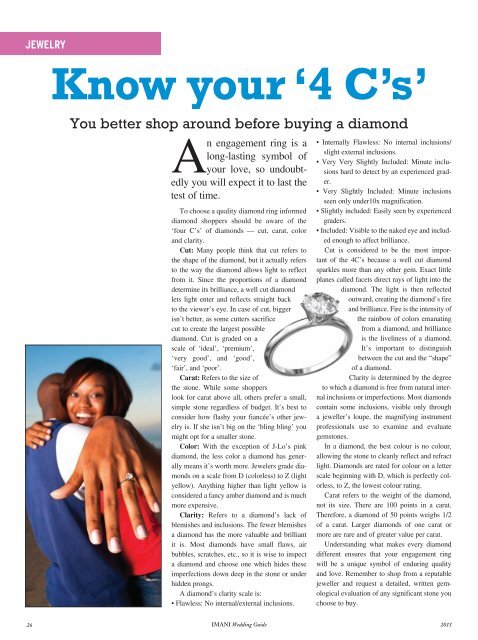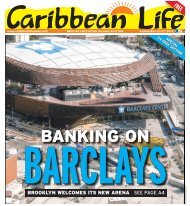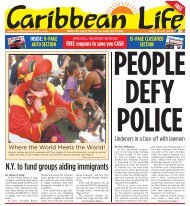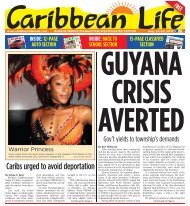Download the magazine (PDF, 10.6 MB) - Caribbean Life
Download the magazine (PDF, 10.6 MB) - Caribbean Life
Download the magazine (PDF, 10.6 MB) - Caribbean Life
Create successful ePaper yourself
Turn your PDF publications into a flip-book with our unique Google optimized e-Paper software.
JEWELRY<br />
Know your ‘4 C’s’<br />
You better shop around before buying a diamond<br />
An engagement ring is a<br />
long-lasting symbol of<br />
your love, so undoubtedly<br />
you will expect it to last <strong>the</strong><br />
test of time.<br />
To choose a quality diamond ring informed<br />
diamond shoppers should be aware of <strong>the</strong><br />
‘four C’s’ of diamonds — cut, carat, color<br />
and clarity.<br />
Cut: Many people think that cut refers to<br />
<strong>the</strong> shape of <strong>the</strong> diamond, but it actually refers<br />
to <strong>the</strong> way <strong>the</strong> diamond allows light to reflect<br />
from it. Since <strong>the</strong> proportions of a diamond<br />
determine its brilliance, a well cut diamond<br />
lets light enter and reflects straight back<br />
to <strong>the</strong> viewer’s eye. In case of cut, bigger<br />
isn’t better, as some cutters sacrifice<br />
cut to create <strong>the</strong> largest possible<br />
diamond. Cut is graded on a<br />
scale of ‘ideal’, ‘premium’,<br />
‘very good’, and ‘good’,<br />
‘fair’, and ‘poor’.<br />
Carat: Refers to <strong>the</strong> size of<br />
<strong>the</strong> stone. While some shoppers<br />
look for carat above all, o<strong>the</strong>rs prefer a small,<br />
simple stone regardless of budget. It’s best to<br />
consider how flashy your fiancée’s o<strong>the</strong>r jewelry<br />
is. If she isn’t big on <strong>the</strong> ‘bling bling’ you<br />
might opt for a smaller stone.<br />
Color: With <strong>the</strong> exception of J-Lo’s pink<br />
diamond, <strong>the</strong> less color a diamond has generally<br />
means it’s worth more. Jewelers grade diamonds<br />
on a scale from D (colorless) to Z (light<br />
yellow). Anything higher than light yellow is<br />
considered a fancy amber diamond and is much<br />
more expensive.<br />
Clarity: Refers to a diamond’s lack of<br />
blemishes and inclusions. The fewer blemishes<br />
a diamond has <strong>the</strong> more valuable and brilliant<br />
it is. Most diamonds have small flaws, air<br />
bubbles, scratches, etc., so it is wise to inspect<br />
a diamond and choose one which hides <strong>the</strong>se<br />
imperfections down deep in <strong>the</strong> stone or under<br />
hidden prongs.<br />
A diamond’s clarity scale is:<br />
• Flawless: No internal/external inclusions.<br />
• Internally Flawless: No internal inclusions/<br />
slight external inclusions.<br />
• Very Very Slightly Included: Minute inclusions<br />
hard to detect by an experienced grader.<br />
• Very Slightly Included: Minute inclusions<br />
seen only under10x magnification.<br />
• Slightly included: Easily seen by experienced<br />
graders.<br />
• Included: Visible to <strong>the</strong> naked eye and included<br />
enough to affect brilliance.<br />
Cut is considered to be <strong>the</strong> most important<br />
of <strong>the</strong> 4C’s because a well cut diamond<br />
sparkles more than any o<strong>the</strong>r gem. Exact little<br />
planes called facets direct rays of light into <strong>the</strong><br />
diamond. The light is <strong>the</strong>n reflected<br />
outward, creating <strong>the</strong> diamond’s fire<br />
and brilliance. Fire is <strong>the</strong> intensity of<br />
<strong>the</strong> rainbow of colors emanating<br />
from a diamond, and brilliance<br />
is <strong>the</strong> liveliness of a diamond.<br />
It’s important to distinguish<br />
between <strong>the</strong> cut and <strong>the</strong> “shape”<br />
of a diamond.<br />
Clarity is determined by <strong>the</strong> degree<br />
to which a diamond is free from natural internal<br />
inclusions or imperfections. Most diamonds<br />
contain some inclusions, visible only through<br />
a jeweller’s loupe, <strong>the</strong> magnifying instrument<br />
professionals use to examine and evaluate<br />
gemstones.<br />
In a diamond, <strong>the</strong> best colour is no colour,<br />
allowing <strong>the</strong> stone to cleanly reflect and refract<br />
light. Diamonds are rated for colour on a letter<br />
scale beginning with D, which is perfectly colorless,<br />
to Z, <strong>the</strong> lowest colour rating.<br />
Carat refers to <strong>the</strong> weight of <strong>the</strong> diamond,<br />
not its size. There are 100 points in a carat.<br />
Therefore, a diamond of 50 points weighs 1/2<br />
of a carat. Larger diamonds of one carat or<br />
more are rare and of greater value per carat.<br />
Understanding what makes every diamond<br />
different ensures that your engagement ring<br />
will be a unique symbol of enduring quality<br />
and love. Remember to shop from a reputable<br />
jeweller and request a detailed, written gemological<br />
evaluation of any significant stone you<br />
choose to buy.<br />
26 IMANI Wedding Guide 2011









